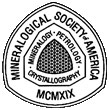 |
The Mineral Identification Key |  |
 |
The Mineral Identification Key |  |
Table IIIB-1: Nonmetallic Luster; Hardness 7 to 10; Has a Prominent Cleavage. (Can not be scratched by quartz.) [Previous Table] [Next Table]
| Cleavage | Hardness | Color | Luster | Name | System | Habit | SG | Notes |
| One direction: Perfect | 6 to 7 | Grey, Green to Yellowish-green, Pinkish, Brown, Blue, Purple, Colorless | Vitreous, may be pearly on cleavage surfaces | ZOISITE (Epidote Group) Ca2Al3(SiO4)3(OH) |
Orthorhombic | Usually in aggregates of crude parallel crystals with vertical striations on the faces, more rarely as well-formed prismatic crystals in clusters or singly | 3.15 to 3.36 | The blue gem variety "tanzanite" and pink gem variety "thulite" are rare. |
| One direction: Perfect | 6½ to 7 | Green to Yellow-green, Yellow, Grey, Brownish-green, Greenish-black, Black | Vitreous to sub-vitreous, dull in weathered crystals and massive materials | EPIDOTE |
Monoclinic | Usually in short to long prismatic crystals, may also be thick tabular or acicular (over 200 different forms are known), massive, coarse to fine granular, rarely fibrous | 3.38-3.49 | Commonest of the Epidote Group species. Most of the Epidote group minerals may exhibit a second, poor, cleavage, but it is usually not seen. |
| Cleavage | Hardness | Color | Luster | Name | System | Habit | SG | Notes |
| One direction: Perfect | 6½ to 7 | Colorless to White, Grey, Pale-brown to Pale-yellow, more rarely Pale-blue to Pale-green | Vitreous to sub-vitreous, silky in fibrous material, may be dull on weathered surfaces | SILLIMANITE Al2SiO5 |
Orthorhombic | Usually as crude prismatic crystals with a nearly square cross-section, surfaces often rough and altering to muscovite, may be in columnar to fibrous aggregates ("fibrolite") | 3.23 to 3.27 | Restricted to high-temperature and pressure metamorphic environments. |
| One direction: Perfect | 6½ to 7 | White to Greyish-white, Colorless, Pinkish-white to Pale-lavender, more rarely Greenish to Yellowish, Brown, Rose-red to Dark-red | Vitreous to sub-adamantine, "brilliant" | DIASPORE AlO(OH) |
Orthorhombic | Usually in thin platy crystalline aggregates, crystals thin, platy, may be prismatic or acicular, rarely tabular | 3.35 to 3.45 | Very brittle. Often mistaken for milky to greyish quartz. |
| One direction: Perfect (pinacoidal, basal) | 8 | Colorless to Milky-white, Yellowish, to Brownish, Pinkish, Bluish, Greenish | Vitreous, may be somewhat greasy on fracture surfaces | TOPAZ Al2SiO4(F,OH)2 |
Orthorhombic | Usually as stout prismatic to equant crystals, with or without pyramidal terminations | 3.4 to 3.6 | Largely restricted to granites, granite-pegmatites, and rhyolites. |
| Cleavage | Hardness | Color | Luster | Name | System | Habit | SG | Notes |
| Two directions: Perfect in both directions (prismatic) | 6 to 7 | Dark-green to Medium-green to (more rarely) Pale-green, White to Grey or Bluish-grey, Lavender to Violet | Vitreous to sub-vitreous, may be dull in granular material | JADEITE (Pyroxene Group) Na(Al,Fe)Si2O6 |
Monoclinic | Usually in compact massive material, granular or short fibrous, with cleavage not apparent | 3.24 to 3.43 | Massive material often a mix of jadeite and diopside, crystals extremely rare. Jade in part (jade also includes nephrite variety of tremolite) |
| Two directions: Perfect in both directions (prismatic) | 6½ to 7 | Grey to White, Colorless, Tan, Yellow, Pale-green to Bright-green ("hiddenite"), Pink to Lilac to Violet ("kunzite") | Vitreous to sub-vitreous | SPODUMENE (Pyroxene Group) LiAlSi2O6 |
Monoclinic | Crystals are usually prismatic with a diamond shaped cross-section; but matrix-frozen crystals - the most commonly seen - tend to show only two adjacent faces, the other two not developed; then they look like a triangular prism with two developed faces and a rough base to the 'triangle' - only half of the complete prism developed. | 3.03 to 3.23 | Crystals often very large, to 14 meters or more, crystals faces usually have a wood-grain look to them, gem quality material often with acid-etched crystal faces, heavily vertically striated. |
| Two directions: One perfect (basal) and one good (prismatic) | 6½ to 7 | Colorless to White, more rarely Pale-yellow, Pale-pink or Pale-brown | Vitreous | BERTRANDITE Be4Si2O7(OH)2 |
Orthorhombic | Usually as tiny to micro tabular crystals, also granular aggregates | 2.57 to 2.63 | Usually associated with beryl in pegmatites. Cleavage often not seen |
| Cleavage | Hardness | Color | Luster | Name | System | Habit | SG | Notes |
| Three parting directions: Fair rhombohedral and basal (looks like cleavage on a small scale) | 9 | Dark-grey to Light-grey to Blue-grey to Blue (sapphire), Red (ruby), and Yellow, Brown and Green in sapphire | Vitreous to sub-vitreous and dull | CORUNDUM Al2O3 |
Trigonal | Usually massive, granular (emery) and as barrel-shaped prismatic hexagonal crystals | 4.0 | Extremely hard – can only be scratched by moissanite (silicon carbide) and diamond. |
| Four directions: Perfect in four directions (pyramidal) | 10 | Colorless to Yellow, Brown or Grey, may be Pink, Red, Blue, Green, and Black (due to inclusions) | Adamantine | DIAMOND C |
Isometric | Typically in octahedral crystals, usually appearing somewhat rounded on the edges, also as dodecahedral, tetrahedral, and cubic crystals, also often appearing somewhat rounded | 3.50 to 3.53 | Extremely hard – no other mineral or material will scratch it. Gem material is limited to lamproites and kimberlites ("blue-earth") pipes and alluvial deposits eroded out of those pipes. |
[ Table of Contents ] [ Introduction ] [ Identification Kit ] [ Mineral Properties ] [ Environments & Associations ] [ In Conclusion ] [ The Mineral ID Key ]
[Previous Table] [
Next Table]